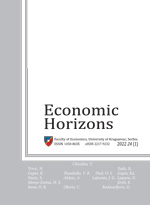
THE JOURNAL IS PUBLISHED
THREE TIMES A YEAR
in April, August and December
Adedayo Emmanuel Longe1, Caleb Olugbenga Soyemi2, David Adeiza Agbanuji3, Oladayo Omitogun1 and Idowu Jacob Adekomi2
1Centre for Petroleum, Energy Economics and Law, University of Ibadan, Ibadan, Oyo State, Nigeria
2Department of Economics, Olabisi Onabanjo University, Ago Iwoye, Ogun State, Nigeria
3Energy Economics, Management and Policy, Emerald Energy Institute, Uniport, Nigeria
The study accounts for the structural break effect in the context of Nigeria. According to the findings obtained, the linear Autoregressive Distributed Lag (ARDL) bounds test reveals that the possibility of a long-term co-integrating relationship is inconclusive. When the study further accounts for asymmetry and the structural break period, however, the Nonlinear Autoregressive Distributed Lag (NARDL) bounds test reveals that there is no long-term co-integrating relationship among the variables in Nigeria within the specified period. According to the results of the NARDL test, both the positive and the negative changes in the oil price and energy use have a negative significant impact on economic growth in Nigeria in the short run, whereas the Consumer Price Index (CPI) exerts a positive and significant impact on economic growth in the short run. The Error Correction Model (ECM) result shows that the independent variables can correct about 94% of the short-run deviation of economic growth from equilibrium in the long run. The study concludes that, irrespective of the changes in the Bonny Light crude oil price, its impact remains the same on the Nigerian economic growth.
Keywords:
JEL Classification:
Since March 2015, the Journal is indexed in DOAJ
Since November 2013, the Journal is indexed in ProQuest – ABI/INFORM
Since October 2013, the Journal is indexed in Cabell’s Directories
Since September 2013, the Journal is indexed in Index Copernicus Journals Master List 2012
Since March 2013, the Journal has been evaluated and accepted for listing in EconLit (American Economic Association Publications)
Since January 2013, the Journal has been included into EBSCO’s databases
Since November 2012, the Journal has been included into Ulrich’s Periodicals Directory
Since March 2015, the Journal is indexed in DOAJ
Since November 2013, the Journal is indexed in ProQuest – ABI/INFORM
Since October 2013, the Journal is indexed in Cabell’s Directories
Since September 2013, the Journal is indexed in Index Copernicus Journals Master List 2012
Since March 2013, the Journal has been evaluated and accepted for listing in EconLit (American Economic Association Publications)
Since January 2013, the Journal has been included into EBSCO’s databases
Since November 2012, the Journal has been included into Ulrich’s Periodicals Directory